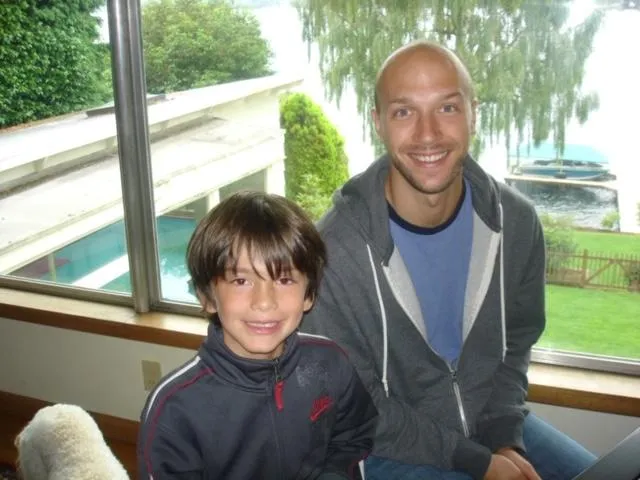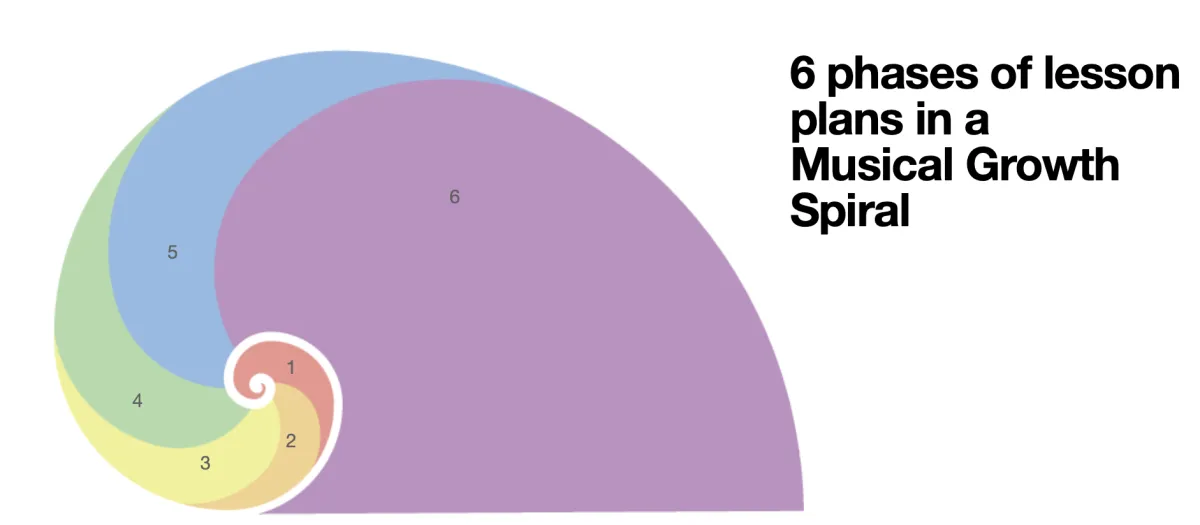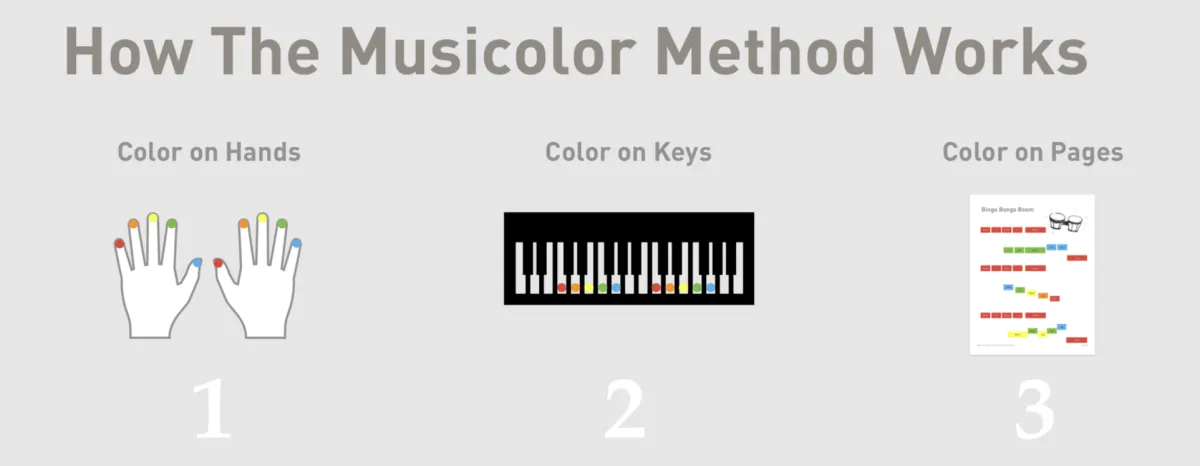About
Musicolor Method

How Musicolor Method Uses Color As Educational Scaffolding
The Musicolor Method utilizes color in a unique and effective way to facilitate music learning, especially for young students. Here's how color is integrated into the learning process.
Color-Coded Notes
Each musical note is assigned a specific color. This visual association helps young learners to understand and remember musical notes more easily. It's particularly helpful for children who are not yet proficient in reading standard musical notation.
Simplified Music Reading
By using colors, the method simplifies the process of reading music. This allows students to focus on the mechanics of playing their instrument and the sound of the music, rather than getting bogged down by the complexities of traditional music notation.
Engaging and Fun
The use of colors makes learning more engaging and fun for children. It appeals to their sense of sight, adding a playful element to music education.
Building a Foundation
This color-based approach lays a solid foundation for young learners. As they progress, they can easily transition to standard music notation, having already developed an understanding of musical concepts through the color system.
Enhanced Memory and Learning
Color associations can enhance memory and learning. By associating notes with colors, children can more easily recall and play them, which accelerates their learning process.
Overall, the use of color in the Musicolor Method makes music more accessible and enjoyable for young learners, helping them to grasp fundamental musical concepts in a way that is both effective and delightful.
How Musicolor Method started
Hi, I’m Andrew!
A Brooklyn Dad who’s thought a lot about helping children find their unique gift, or what I like to call, “their thing.”
I discovered music can be a great path for personal development and discovery, even if they never become a professional musician. And there’s now tons of studies proving the brain development benefits of learning an instrument.
But how did I get here? It’s the early 2000s and my son Alejandro is in preschool. It’s a lovely school and yet, I can’t leave the classroom. Alejandro has deep attachment issues. He is so terrified that I have to sit in the corner of the class.
I’m so frustrated. There’s so many things I can be doing right now!
But I’m also deeply worried. How can my son fly on his own? He can’t let go...
We tried a bunch of things...
Soccer, baseball, karate, art classes. Nothing seemed to really get his attention. But then he started asking for music lessons.
“Wow. I guess the apple didn’t fall too far from the tree.”
You see, I am a musician and composer but I never wanted to impose my will on him. My own childhood with tiger parents was something I was very wary of.
So I say,
“Okay I’ll just find you a local music teacher.”
To my utter amazement, I could not. No one would accept a student so young. They all told me,
“Come back when he’s 7 or 8.”
That’s insane!
Alejandro was born singing. He’s so musical!
There’s no way I could wait 4 or 5 years!
So I turned to him and said, “Alejandro, I’ll teach you music. We’ll start with piano.”
“ Now ?”
His eyes were bright with excitement.
“Um, I need a few days to get you a book.”
Back in college, I was a Music Education major...
In fact, I received a massive scholarship to NYU to be a music teacher. But I had never made it a professional focus. I figured this homeschooling project shouldn’t be that hard.
But the lessons were hard.
The traditional methods and books I had found were not suitable for young beginners. They were backwards! It was like trying to teach grammar before you learned to say “Hello!”
And, to make it more difficult, I suddenly had a bunch of Alejandro’s friends instantly sign up for my lessons. I kept trying different method books including some well known ones like the Suzuki method. But teaching kids who’s parents couldn’t read music using these old methods was proving impossible.
One day, I happened to observe my son’s teacher using translucent colored tape to teach reading.
I had an epiphany!
I could use color as a direct label!
I didn’t need to rely on abstract numbers, letters or symbols. Every child knows color!
I went home and sat at my desk
For ten years, I was at the forefront of web design and information architecture. I co-founded a digital agency and led design teams for Fortune 500 clients at major ad agencies. As I leaned back and looked at some of my old design books.
I began to realize, this problem was a design problem.
Another light bulb went off in my head!
"Music notation is a visual design challenge! This is something I can solve!"
Applying "Design Thinking"
I realized my audience of young children was not being served by traditional method books. In fact, that’s why those teachers told me to come back later. The books they were using were designed for 7 or 8 year olds!
I started designing simplified notation using color. Music notation that anyone, even preliterate children could read!

I had a third "lightbulb" moment
I connected an idea I discovered studying financial markets - the Fibonacci number series. This sequence of numbers is found throughout nature and describes a spiral shape found in everything from plants, organisms, minerals, macro and micro and even the price movement of financial markets.
I saw we could apply this “growth spiral” shape to not only physical growth, but also mental growth.
Starting with a small seed of an idea, we spiral outward in complexity and scope. It’s how humans learn. To go out of order breaks the natural order of things. This is why so many other methods lead to confusion or overwhelm. Boredom or tears of frustration.

The growth spiral is the map of our Musicolor Method curriculum
It has proven incredibly powerful and successful.
After years of teaching alone, I started training a few more teachers to teach alongside me. The results were phenomenal. I continued hiring and training the best teachers who were open-minded enough to try my radical experiments.
Today thousands of students have benefited from our method
And, Alejandro, my first student, is a successful graduate of the NYC public school system. He’s a senior at Brown University where he’s exploring his passion of urban planning and architecture. And yes, he still plays and sings...everyday.
I didn’t set out to start a music school. I didn’t set out to invent a new music curriculum.
I just wanted to be a good Dad.
Thanks for reading!
Andrew Ingkavet
Brooklyn, NY
USA

The Symphony of Early Childhood Awaits:
Music has the power to change brains at an early age. Activate your child's genius today!
Are You Ready to Embrace Holistic Growth for Your Little One?
Schedule a Call Now
and we'll learn more about your child, their learning styles, preferences and schedule to match you with the perfect in-home music teacher.
Formerly Park Slope Music Lessons
@ 2024 Shoreline Music Lessons, dba as Musicolor Method. All rights reserved. Unauthorized use prohibited.

